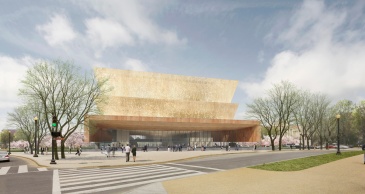What might be Lagos’s most internationally recognizable building project since the 1980s isn’t a skyscraper or a suspension bridge — it’s a one-room schoolhouse. The now well-known A-frame bobs in the murky surf of Makoko, one of Lagos’s largest slums, providing a learning space for a community of 100,000+ people not officially recognized by the city government. Designed by Nigeria’s rising star Kunlé Adeyemi, the project made waves in the architectural world last year for its simplicity, adaptability, and humanity. I first read (and blogged) about the project last fall and was struck by the auroral beauty of the blue-roofed building set against the cooking smoke and plain timber structures of Makoko where new homes are often constructed on a soggy foundation of raw sewage (see episode 2 of the BBC’s documentary Welcome to Lagos). Here was a project that had actually succeeded in that often sought but rarely realized gauntlet of creating low-cost, high-design buildings from recycled material to benefit poor communities. Write-ups poured in from the New York Times, The Guardian, and many others, and Makoko Floating School splashed across my newsfeed for several weeks.
Last summer when I was in Lagos for the first time, I saw the school from the Third Mainland Bridge moments before glimpsing the city’s skyline and I have to admit that the school stole the spotlight. The Third Mainland Bridge is the longest bridge in Africa, meandering from Ebute Meta to Lagos Island, and, about halfway along, it provides the perfect balcony to view Akeyemi’s school (where I took the photo below). Akeyemi certainly knew how to make the most of a small-scale project that other architects might have scoffed at. For making a name for himself Akeyemi had good training — he worked at Koolhaas’s firm OMA for nearly a decade before founding his own firm NLÉ in 2010. His relationship with Koolhaas adds a fascinating dimension to Adeyemi’s project since Koolhaas’s Harvard Project on the City produced some of the most provocative writing on Lagos to date. Koolhaas challenged outside observers to see Lagos as being at the “forefront of globalizing modernity” — a dynamic urban space that had outgrown Western notions of the city and carrying capacity to become a “self-organizing” entity that completely disorientated visitors but somehow “worked.” Within this paradigm, it’s not surprising that Adeyemi saw that the future was in Lagos and returned to set-up shop. But of course his move and the civically-concerned design he’s been involved in since being back puts a twist on Koolhaas’s “self-organizing” thesis.
Away from the stratosphere of starchitects, the school itself has become the pride of Makoko, a place for a handful of youths to get an education long denied to the unincorporated fishing community. Every day local children park their hollowed out wooden canoes around the floating school and gather on its open-air decks for class, and in the evenings the buoyant building becomes a community center for local leaders. The project is only the prototype of a much larger masterplan that Adeyemi envisions for Makoko, and if funding comes through all of the neighborhood’s stilt-supported shacks will one day be replaced by floating A-frames. When that happens, it may just be a sight to rival Eko Atlantic — the megaproject of office buildings developing on the other side of the city and architectural spectrum.
(Mark Duerksen 2014)















